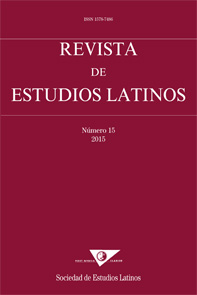Oh brother!: Los Coen ante la Tradición Clásica
DOI:
https://doi.org/10.23808/rel.v15i0.87700Palabras clave:
Coen; Odisea; Tradición Clásica; mito; recreación; mímesisResumen
El presente trabajo ofrece una descripción de la relación advertible entre La Odisea y Oh brother!. Tras hacer un estado de la cuestión, se selecciona la película Oh brother! de los Hermanos Coen (O brother, where art thou?, 2000) y se estudia en relación con La Odisea. Se analiza cómo se ha llevado a cabo la adaptación de la temática, estructura y mensaje del mito en la nueva versión, qué modificaciones han experimentado estos aspectos y qué función cumple el mito dentro de la trama cinematográfica. Tras esto, el siguiente apartado ahonda en la figura de los autores de la película y en su relación con la fuente posible. Finalmente, se trata de esclarecer si existe una relación de mímesis entre ella y la película y, en caso afirmativo, determinar de qué tipo de mímesis se trata.
Descargas
Citas
Balló, J. & Pérez, X. (2014): La semilla inmortal: Los argumentos universales en el cine, Barcelona, Anagrama.
Cano Alonso, P. (1998): “Dos apuntes iberoamericanos a la tradición cinematográfica de la cultura clásica: La vida íntima de Marco Antonio y Cleopatra y El reñidero”, Cuadernos de filología clásica: Estudios latinos 15, 585-592.
Cano Alonso, P. (1999): “Aspectos de mitología griega en el cine”, en Casadesús i Bordov, F. J. (coord.), La mitologia : II Curs de pensament i cultura clàssica, Universitat de les Illes Balears, 131-151
Cano Alonso, P. (2004): “La épica cristiana: una tradición cinematográfica”, RELat 4, 199-222.
Cano Alonso, P. (2011): “Capítulo cuarto: Géneros cinematográficos y mundo antiguo” en Dupla Ansuátegui, A. (coord.), El cine de romanos en el siglo XXI, Universidad del País Vasco, 59-78.
Cristóbal López, V. (2000): “Mitología clásica en la literatura española: consideraciones generales y bibliografía”, Cuadernos de Filología Clásica. Estudios Latinos 18, 29-76.
Cristóbal López, V. (2005): “Tradición Clásica. Tradición y Poligénesis”, E-Excellence-Liceus ISBN:84-96479-25-0. <http://www.liceus.com/bonos/compra1.asp?idproducto=357> [2/09/2015].
Flensted-Jensen, P. (2002): “Something old, something new, something borrowed: The Odsyssey and O Brother, Where art thou?”, Classica et Medievalia 53, 13-30.
García Fuentes, M. C.(1993): “Filmografía mítica en el péplum”, Cuadernos de Filología Clásica. Estudios Latinos 4, 301-350.
García Jurado, F. (2004): “Estudios culturales. La crisis de la cultura clásica/ burguesa”, E-Excellence-Liceus ISBN 84-96359-36-0. <http://www.liceus.com/bonos/compra1.asp?idproducto=42> [2/09/2015].
Goldhill, S. (2007): “Naked and Oh brother where art thou? The Politics and Poetics of Epic Cinema” en Graziosi, B. & Greenwood, E.(eds.), Homer in the twentieth century. Between World Literature and the Western Canon, Oxford University Press, 245-168.
Grenes, C. S. (2009): “Lo grotesco y lo cómico en Oh Brother, Where Art Thou? desde la perspectiva de F. O’Connor” Simposio Internacional sobre “Razón, ficción y fe – Flannery O’Connor”. <https://poeticaycine.files.wordpress.com/2009/06/grotesco_comico_oh-brother_0530.pdf> [1/11/2015].
Gómez Moreno, A. (2006): “Letras latinas, tradición clásica y cultura occidental”, Humanista 7, 7-54.
Greub, T. (2011): “O Odyssee, Where Art Thou? Homers Odyssee und ihre morphomatischen Transformationen am Beispiel dreier zeitgenössischer Filme“ en Blamberger, G. & Boschung, D. (eds.), Morphomata. Kulturelle Figurationen: Genese, Dynamik, Medialität, Deutsche Nationalbibliothek, 307-343.
Halliwell, S. (2002): Aesthetics of Mimesis: Ancient Texts and Modern Problems, Princeton, Princeton University Press.
Heckel, H. (2005): “Zurtick in die Zukunft via Ithaca, Mississippi: Technik und Funktion der Homer-Rezeption in O Brother, Where Art Thou?”, International Journal of the Classical Tradition, 11, 4, 571-589.
Homero: La Odisea. (versión esp. de C. García Gual), Madrid, Alianza Editorial, 2005.
Laguna Mariscal, G. (1994): “Literatura Comparada y Tradición Clásica: Quevedo y sus fuentes clásicas”, Anuario de estudios filológicos 17, 283-294.
Laguna Mariscal, G. (2000): “La influencia de la poesía latina en la española durante el Renacimiento” en Cabanillas Núñez, C. M. (coord.), Actas de las II Jornadas de Humanidades Clásicas, I.E.S. Santiago Apóstol, Almendralejo, 40-50.
Laguna Mariscal, G. (2004): “¿De dónde procede la denominación ‘Tradición Clásica’?”, Cuadernos de Filología Clásica. Estudios Latinos 24, 83-93.
Lapeña, O. (2007): “La infancia en el ‘peplum’ : primeros apuntes”, Faventia: Revista de Filología Clásica 29, 173-187.
Lapeña, O. (2008): “La ciudad antigua en el cine: mucho más que un decorado” en Castillo Pascual, M. J. (coord.), Congreso Internacional ‘imagines’. La Antigüedad en las artes escénicas y visuales: Universidad de la Rioja, Logroño, 231-252.
López Muñoz, M. (1991): “Horacio, Garcilaso y el tema del beatus ille”, Estudios de Filología Latina, 109-137.
Roisman, H. (2001): “Verbal Odysseus: Narrative strategy in The Odyssey and in The Usual suspects” en Winkler, M. M. Classical Myth and Culture in the Cinema, Oxford, Oxford University Press, 51-72.
Tovar Paz, J. (2002): “Medea de Séneca en Así es la vida (2000) filme de Artura Ripstein”, RELat 2, 169-195
Tovar Paz, J. (2004): “Una puerta a la lectura de Martín (H) (1997), filme de Adolfo Aristaráin; la puerta de la Tradición Clásica”, Puertas a la lectura 17, 173-182.
Tovar Paz, J. (2006): Un río de fuego y agua: lecciones sobre mitología y cine, Cáceres, Universidad de Extremadura.
Sartori, B. (2000): “La Odisea de los Coen”, Diario El Mundo, Suplemento “El Cultural”. <http://www.elcultural.com/revista/cine/La-odisea-de-los-Coen/15269> [2/09/2015].
Winkler, M. M. (2001): Classical Myth and Culture in the Cinema, Oxford, Oxford University Press.
Descargas
Publicado
Cómo citar
Número
Sección
Licencia
Derechos de autor 2015 Revista de Estudios Latinos

Esta obra está bajo una licencia internacional Creative Commons Atribución-NoComercial-SinDerivadas 4.0.
Los originales publicados en las ediciones impresa y electrónica de esta revista son propiedad de las personas autoras de los mismos y se podrán difundir y transmitir siempre que se identifique la fuente original y la autoría en cualquier reproducción total o parcial de los mismos, y siempre que no tengan una finalidad comercial.






